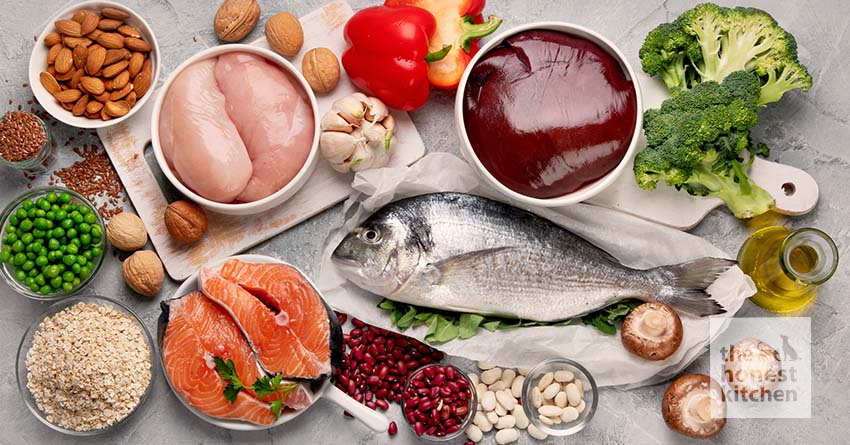Warming vs. Cooling: What Protein Is Best for Dogs?

Did you know that, just like humans, dogs need different types of food depending on their energy levels and body temperatures?
It’s true: Just like you wouldn’t drink hot chocolate during a summer heatwave or an ice cream during a blizzard (probably), certain proteins may not be ideal for your dog depending on their temperature.
According to traditional Chinese medicine philosophy, different proteins have varying energies, rendering them as “warming,” “cooling” or “neutral.” Understanding which foods fall where and whether your dog runs hot, cold or somewhere in between can help you support their comfort and overall well-being.
Let’s explore warming and cooling proteins and how you can choose the right option for your dog.
The Role of Protein in a Healthy Dog’s Diet
Protein contains organic compounds and amino acids valuable for building muscle, cartilage nails and healthy coats , making it crucial in every pup’s diet. It’s also essential in adult and senior dogs’ diets, as it helps them maintain energy, repair tissue, protect their immune systems and preserve their muscle mass, even as they age.
Proteins can fall into two broad categories — common and novel — both of which could be valuable for your dog.
Common proteins are what you typically find in most dog food, like beef, lamb, chicken and fish.
Novel proteins like rabbit, quail and duck are less common. They may be ideal if your dog has allergies to common proteins or if you want to introduce a little variety into their diet.
But it’s important to note that not all forms of protein are suitable for dogs. For example, raw chicken may expose them to bacteria like Salmonella. Also, while “exotic,” not all novel proteins will sit right with your pet. So, watch their behavior after feeding them to determine whether to incorporate more or stick with common proteins.
Keep in mind that there’s no single “best” protein for dogs. Proteins work differently for different dogs. Consider your pet’s unique needs and preferences, and stick to options that cater to them.
Want to expand your dog’s diet with a variety of proteins? Check out these healthy meat options.
How Much Protein Does a Dog Need ?
The right amount of protein depends on your dog’s age, activity level, lifestyle and body weight, so there’s no standard number.
That said, the American Association of Feed Control Officials (AAFCO) and the European Pet Food Industry (FEDIAF) do offer some general guidelines. According to AAFCO, puppies, pregnant and nursing dogs require a minimum of 22.5% protein, and adult dogs 18% dry matter (DM). The association recommends even higher quantities for active or large breeds.
FEDIAF offers more detailed nutritional guidelines, suggesting the following:
Pups younger than 14 weeks and pregnant dogs: 25 grams protein/100 grams DM
Late growth stage dogs (older than 14 weeks): 20 grams protein/100 grams DM
Adult dogs: 18 to 21 grams protein/100 grams DM, depending on their maintenance energy requirement (MER).
These recommendations aren’t set in stone. Consider your dog’s needs, including their breed, age and health conditions, and be sure to consult your vet for customized guidance.
What Are Warming and Cooling Proteins?
Warming and cooling proteins are based on a traditional Chinese medicine philosophy that argues that different foods have varying energetic qualities. According to this philosophy, warming foods have a “yang” energy, typically nourishing dogs and stimulating their energy. Conversely, cooling proteins have a “yin” energy and tend to be more calm and settling.
Let’s take a look at some warming, cooling and neutral proteins and when may be a good option for your pet:
Warming Proteins (for Cold Energy)
Warming proteins are considered suitable for dogs with too much cold energy. They have a yang (warm) energy that helps balance them out, and the belief is that this raises their vitality.
Pets with cold energy may show signs like body weakness, arthritis, a lack of energy, a slow metabolism or weight loss. They may also exhibit heat-seeking behaviors like excessive snuggling, which is exacerbated by cold weather. Have a pup that always needs to cuddle in a blanket? These are likely the protein options for them.
Examples of warming proteins include:
Lamb
Goat
Mutton
Chicken
Venison
Trout
Supporting warm vegetables and grains include:
Squash
Pumpkin
Sweet potatoes
Sorghum
Oats
Cooling Proteins (for Hot Energy)
Cooling proteins are ideal for dogs with hot energy. They’re thought to have a calming effect, which can help balance out their energy levels.
Pets with hot energy may experience excessive panting, red eyes and skin around the mouth, hot spots , hair loss, inflammation and anxiety or aggression. They may exhibit cold-seeking behaviors, like sprawling out on the floor. Have a pup that always wants to lay on a cool surface and is prone to itchiness? You may want to try these proteins for them.
Examples of cooling proteins include:
Whitefish
Duck
Rabbit
Supporting cooling vegetables and grains include:
Cucumber
Broccoli
Barley
Buckwheat
Kelp
Cranberry
Neutral Proteins
Neutral proteins have little to no impact on dogs’ Qi, so they may be suitable if your dog doesn’t show too much cold or hot energy.
Neutral proteins, vegetables, and grains include:
Turkey
Beef
Salmon
Pork
Bison
Lentils
Papaya
Carrots
Brown rice
Rye
Neutral Options From The Honest Kitchen
One of the benefits of The Honest Kitchen’s recipes is that many are made with neutral ingredients. This makes them a great everyday option for most pets, offering a balanced nutritional foundation that supports long-term health and well-being.
Neutral foods are especially versatile because they give you the flexibility to adjust based on your dog’s specific needs. For example, if your dog shows signs of cool energy — such as lethargy or a tendency to seek out warmth — you might enhance their meal by mixing in warming ingredients like pumpkin, sweet potato or even a trout topper. On the other hand, if your pet tends to run hot, you could supplement with cooling additions like duck, banana or spinach.
Some of our balanced recipes include:
These provide a solid starting point that works well on its own or as a customizable canvas, depending on your dog’s temperament and energy levels.
Single-Source Protein vs. Multi-Source Protein
While understanding your pet’s energy is a good starting point for choosing appropriate foods, it shouldn’t be the only factor that guides your choice. It’s also important to look at the complexity of each food option’s proteins and how easy it is for your pet to digest them.
That’s where the single-source protein vs. multi-source protein consideration comes in.
As their names suggest, single-source protein dog food contains protein from one source, while multi-source food combines meat from two or more sources. Single-protein foods may be a preferable option for dogs with allergies or digestion issues, as they make it easy for you to identify precisely what affects your dog. However, they can be pricey.
On the other hand, multi-protein foods have a more diverse nutrient profile. This could be great as it gives your dog more nutrients, but also problematic, as it makes it harder to pinpoint the causes of allergies.
At The Honest Kitchen, we offer both! Some of our notable single-ingredient recipes include our line of Limited Ingredient Dehydrated recipes, and we have a variety of multi-protein recipes, with our Whole Grain Beef & Salmon Dehydrated food being a top seller. If you’re unsure what to get your dog, contact our customer service team for a personalized nutritional consultation that takes both your dog’s needs and budget into account.
Raw, Dehydrated, Processed, And Ultra-Processed Foods
The way a food is processed can greatly affect its digestibility, health benefits and nutrient levels.
Raw food is uncooked meat and sometimes vegetables and fruits. It has a high nutrient content since the ingredients remain largely in their original form. However, it can expose your dog to bacteria like Salmonella and it’s not easy to store or travel with, as it requires constant refrigeration.
Dehydrated food is made by removing moisture using very low heat. Like raw meat, it’s nutrient-dense, as it’s exposed to minimal heat. However, it’s easier to store than raw food, as it’s typically shelf-stable.
Processed food like traditional kibble is made by exposing ingredients to medium to high-heat cooking. It’s shelf-stable and more affordable than raw or dehydrated food, but typically offers lower nutritional value. Further, kibbles made with the use of high heat could alter the amino acid structure of proteins, making them unrecognizable to your pet’s body and sometimes resulting in allergy symptoms. (However, if you’re looking for a dry food that’s less processed, cold pressed, roasted and gently dehydrated to retain nutrition and taste, try our Whole Food Clusters ).
Ultra-processed foods are the lowest quality options in terms of nutritional value. This is because many contain meat by-products and artificial preservatives to extend their shelf life.
When shopping for dog food, do your due diligence. Check the guaranteed analysis on the back of each bag for details about how the food is processed. Product packaging can also provide insights into foods’ protein content and quality, helping you choose the best options for your dog.
How To Choose The Best Protein For Your Dog
Remember that a dog’s protein needs can vary based on several factors, so start by researching what your dog needs.
For dogs prone to obesity, like dachshunds, opt for foods with lean, high-quality proteins like lamb, fish and turkey. For highly active dogs, like huskies, focus on options that help meet their high energy needs, like chicken. And, for those susceptible to health conditions (like Labrador retrievers), opt for proteins with a high amino acid content, like eggs and beef, and avoid products containing processed meats.
This isn’t to say you should confine your pup to certain proteins. A great rule of thumb is to feed them like their wild canine counterparts: coyotes, foxes and wolves. These wild animals wouldn’t eat the same thing every day, and your dog doesn’t have to, either.
Choosing Protein for a Dog With a Sensitive Stomach
If your dog shows signs like loose stool, vomiting, or apparent stomach discomfort after eating certain proteins, they may have a sensitive stomach. If so, you may want to ask your vet about following an elimination diet to identify what your pup’s stomach can and cannot handle.
The elimination diet involves introducing new proteins to your pet’s diet and observing how they react to them. You could start with something safe (a protein and vegetable you’re sure your dog is okay with), and after some time, introduce a new protein, then another, and so on, noting whether they cause stomach issues. When you identify what affects your dog, replace it with other protein sources to meet their dietary needs.
That said, not all stomach discomfort is caused by food allergies. Consult your vet before you definitively conclude that a specific product or source of protein is the cause of your dog’s symptoms.
Explore our dehydrated dog food line to support your elimination diet process.
Find The Right Proteins for Your Dog at The Honest Kitchen
Protein is an essential nutrient for dogs at every life stage. It plays a key role in building and maintaining muscle mass, supporting healthy skin, hair, and nails, and aiding in tissue repair and overall wellness.
That said, not all proteins work the same for every dog. It’s important to consider your dog’s individual nutritional needs, sensitivities, or potential allergies when selecting a protein source.
If you’re still learning which ingredients suit your dog best, you might find it helpful to explore limited ingredient options or recipes made with single protein sources. Some of the foods in The Honest Kitchen’s dehydrated line fall into this category and may offer a helpful starting point for identifying what works for your pup.
Shop our human grade dog food for great-tasting, high-protein options!





